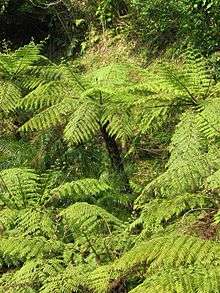Alsophila spinulosa
Alsophila spinulosa, synonym Cyathea spinulosa,[1] also known as the flying spider-monkey tree fern, is a species of tree fern in the family Cyatheaceae.
| Alsophila spinulosa | |
|---|---|
 | |
| Scientific classification | |
| Kingdom: | Plantae |
| Clade: | Tracheophytes |
| Class: | Polypodiopsida |
| Order: | Cyatheales |
| Family: | Cyatheaceae |
| Genus: | Alsophila |
| Species: | A. spinulosa |
| Binomial name | |
| Alsophila spinulosa (Wall. ex Hook.) R.M.Tryon[1] | |
| Synonyms[1] | |
| |
Description
The trunk of this species can grow to a height of 5 m or more. The stipes are persistent, spiny and purplish towards the base, and covered in brown shiny scales. Fronds are 1–3 m long and three-limbed. The sori, producing the spores, are large and round. Like many tree ferns, it features a "skirt" of dead leaves that do not drop off the crown and form a barrier for parasitic climbing plants.[2]
Distribution and habitat
A. spinulosa occurs in humus soils in shadowed forest locations, and is widely distributed across Asia including China, Nepal, India, Burma, Myanmar, and Japan.[3][2]
Use by humans
The stems are rich in starch and edible. Stem chips also see use as fern chips as a substrate for the cultivation of orchids.[2]
References
- Hassler, Michael & Schmitt, Bernd (June 2019). "Alsophila spinulosa". Checklist of Ferns and Lycophytes of the World. Retrieved 2019-08-20.
- T. C. Huang, ed. (1994). Flora of Taiwan. 1 (2nd ed.). Taipei: Editorial Committee of the Flora of Taiwan. p. 148.
- "Cyathea spinulosa Wall". Catalogue of Life. ITIS. Species 2000. Retrieved 17 March 2017.CS1 maint: others (link)